Adolphe Alexandre Lesrel stands as a significant figure in late 19th and early 20th-century French academic painting. Born in 1839 and living a long life until 1929, Lesrel dedicated his artistic career to the meticulous and evocative portrayal of historical genre scenes, particularly those set in the opulent world of 17th-century France. His work is characterized by an extraordinary attention to detail, historical accuracy, and a polished technique that found favour with collectors both in France and internationally. While deeply influenced by his predecessors and contemporaries, Lesrel carved a distinct niche for himself, becoming a respected member of the French art establishment.
Early Life and Artistic Formation
Adolphe Alexandre Lesrel was born in the small town of Genets, situated in the Manche department of Normandy, northern France, in 1839. This picturesque location, near the iconic Mont Saint-Michel Abbey, provided a backdrop steeped in history, perhaps subtly influencing the young artist's later thematic interests. Seeking formal artistic training, Lesrel made the pivotal move to Paris around 1861. The French capital was then the undisputed centre of the art world, bustling with academies, salons, and the studios of established masters.
In Paris, Lesrel enrolled in the studio of Jean-Léon Gérôme (1824-1904), one of the most prominent and influential academic painters of the era. Gérôme was renowned for his highly finished historical paintings, Orientalist scenes, and mythological subjects, all executed with photographic precision and a strong narrative sense. Studying under Gérôme would have instilled in Lesrel a deep appreciation for rigorous draughtsmanship, careful composition, and the importance of historical research in achieving authenticity in depicting the past. Gérôme's own success in the official Salon system also provided a model for professional advancement.
The Defining Influence of Meissonier
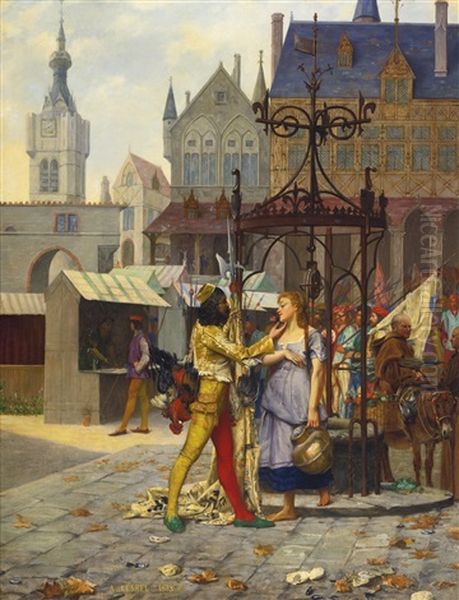
While Gérôme provided foundational training, the artist who arguably exerted the most profound and lasting influence on Lesrel's style and subject matter was Jean-Louis Ernest Meissonier (1815-1891). Meissonier was a towering figure in French art, celebrated, and indeed immensely wealthy, due to his small-scale, exquisitely detailed historical genre paintings. He specialized in scenes from the 17th and 18th centuries, often featuring cavaliers, soldiers, and gentlemen engaged in various activities – reading, playing chess, conversing, or participating in military manoeuvres.
Meissonier's work was characterized by its almost microscopic detail, particularly in the rendering of costumes, accessories, and interiors. He was known for his painstaking research and insistence on accuracy, sometimes going to great lengths to acquire authentic props or study historical documents. Lesrel clearly absorbed Meissonier's approach, adopting a similar focus on historical minutiae and developing a comparable level of technical finesse. The preference for scenes populated by elegantly attired gentlemen in richly furnished settings became a hallmark of Lesrel's own oeuvre, directly echoing Meissonier's popular formula. Lesrel effectively became a master in this specific subgenre, carrying Meissonier's legacy into the early 20th century.
Artistic Style: Precision and Historical Detail
Lesrel's artistic style is best described as Academic Classicism, heavily leaning towards historical genre painting executed with meticulous realism. His primary goal was to recreate scenes from the past, particularly the era of Louis XIII in 17th-century France, with the utmost fidelity. This commitment extended to every element within the composition. Costumes are rendered with an almost archaeological precision, capturing the textures of silk, velvet, lace, and leather. Furniture, weaponry, musical instruments, and architectural details are depicted with equal care, reflecting thorough research into the material culture of the period.
His technique involved smooth, highly finished surfaces with invisible brushstrokes, a characteristic valued within the Academic tradition. He possessed a strong command of draughtsmanship, defining forms clearly and accurately. His compositions are typically well-structured and balanced, often featuring small groups of figures interacting within carefully delineated interior spaces. The lighting is usually clear and even, illuminating the scene and highlighting the rich details of the setting and attire. While highly detailed, his paintings often present an idealized and romanticized vision of the past, focusing on moments of aristocratic leisure, camaraderie, and quiet contemplation.
Themes and Subject Matter
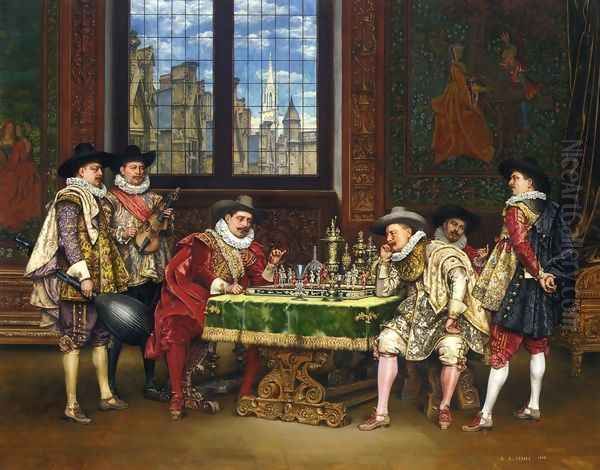
The recurring theme in Lesrel's work is the life of the French aristocracy and gentry during the 17th century. He seemed particularly fascinated by the reign of Louis XIII (1610-1643), an era often romanticized through literature, such as the works of Alexandre Dumas. His canvases typically depict elegantly dressed cavaliers and gentlemen engaged in refined pursuits within luxurious interiors. Common subjects include card games, chess matches, musical performances (often featuring lutes or cellos), connoisseurship (examining artworks or maps), formal conversations, and the quiet enjoyment of wine.
These scenes often convey a sense of calm, order, and sophisticated leisure. The figures are usually portrayed with a certain reserved dignity, their interactions polite and measured. While narrative is present, it is often subtle, focusing more on atmosphere and the depiction of a specific historical milieu than on dramatic action. Lesrel's paintings evoke a sense of nostalgia for a bygone era perceived as more elegant and chivalrous. He masterfully captured the sheen of polished wood, the gleam of metal armour, the intricate patterns of tapestries, and the rich fabrics of the period costumes, immersing the viewer in these carefully constructed historical vignettes.
Broader Artistic Context and Influences
Lesrel worked during a period of significant artistic change, yet he remained largely faithful to the Academic tradition established by his teachers and predecessors. His detailed realism stands in stark contrast to the burgeoning Impressionist movement, led by artists like Claude Monet (1840-1926) and Pierre-Auguste Renoir (1841-1919), which prioritized capturing fleeting moments, the effects of light, and subjective perception over precise rendering and historical narrative.
Beyond Meissonier and Gérôme, Lesrel's style shows an affinity with the broader tradition of Northern European genre painting, particularly the Dutch Masters of the 17th century. Artists like Gerard ter Borch (1617-1681) and Gabriel Metsu (1629-1667) excelled in depicting intimate interior scenes with remarkable attention to texture and detail, themes echoed in Lesrel's work. While perhaps lacking the profound psychological depth of Rembrandt van Rijn (1606-1669), Lesrel certainly shared an interest in the play of light on surfaces and the creation of atmospheric interiors, reminiscent also of Johannes Vermeer (1632-1675).
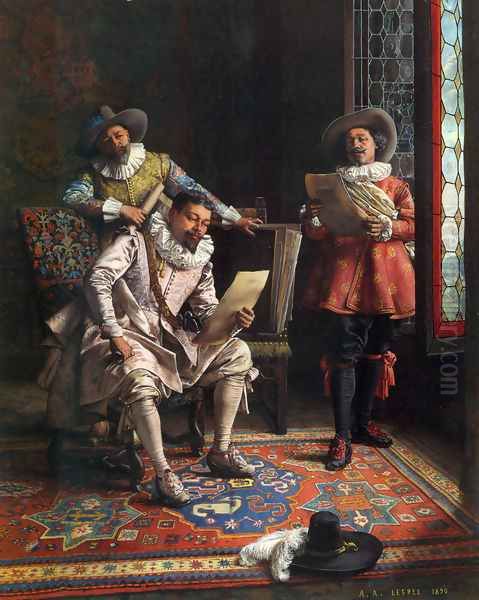
The source material also mentions influences from the Pre-Raphaelite Brotherhood and the Nazarenes. The Pre-Raphaelites, including figures like Dante Gabriel Rossetti (1828-1882) and John Everett Millais (1829-1896), shared Lesrel's interest in historical subjects and detailed execution, though their focus was often more on medieval themes and literary sources, imbued with a different kind of romanticism. The Nazarenes, a group of German Romantic painters based in Rome, such as Johann Friedrich Overbeck (1789-1869), also emphasized clear drawing and historical or religious themes, representing an earlier 19th-century revival of interest in past styles. The mention of Peter Paul Rubens (1577-1640) suggests an appreciation for the richness and dynamism of Baroque painting, although Lesrel's own style is considerably more restrained and polished.
Literary and Cultural Inspirations
The popularity of historical genre painting in the 19th century, the tradition to which Lesrel belonged, was significantly fueled by contemporary literature and a widespread cultural nostalgia. The historical novels of Sir Walter Scott (1771-1832) had captivated European audiences earlier in the century, sparking interest in the medieval and early modern past. In France, the works of Alexandre Dumas, père (1802-1870) were immensely popular and influential.
Dumas's novels and plays, particularly The Three Musketeers (set during the reign of Louis XIII) and Henri III et sa cour, vividly brought French history to life, filled with adventure, romance, and memorable characters like d'Artagnan and the musketeers Athos, Porthos, and Aramis. These works created a romanticized image of the 17th century that resonated strongly with the public and provided rich source material for artists. Lesrel's depictions of cavaliers, courtly manners, and dramatic historical settings align perfectly with the world evoked by Dumas, tapping into this existing cultural fascination with France's swashbuckling past. His paintings offered visual counterparts to these popular literary narratives.
Career Development and Recognition
Lesrel achieved considerable success and recognition during his long career, navigating the official art institutions of his time effectively. He began exhibiting at the prestigious Paris Salon, the official exhibition of the Académie des Beaux-Arts, as early as 1865. Regular participation in the Salon was crucial for an artist's visibility and reputation.
His dedication and skill were formally acknowledged over the years. In 1885, he became a member of the Société des Artistes Français, the body that took over the organization of the Salon after the French state relinquished control. This membership signified his acceptance within the mainstream art community. A significant honour came in 1889 when he received an Honorable Mention at the Exposition Universelle (World's Fair) held in Paris, a major international event showcasing achievements in arts, science, and industry.
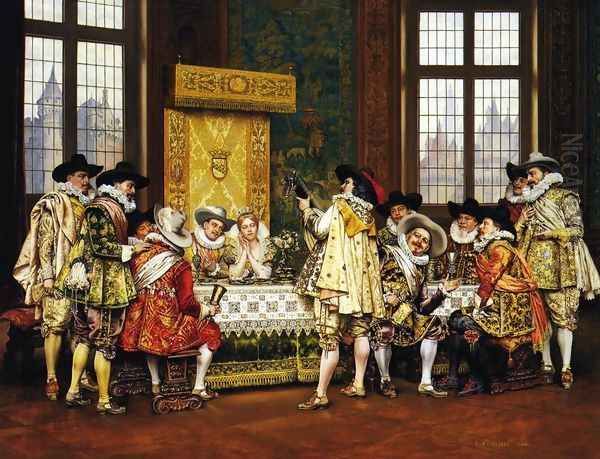
Further recognition followed in 1890 when he became an honorary member (Hors Concours) of the Salon de la Société Nationale des Beaux-Arts. This status often exempted artists from the jury system for Salon submissions, acknowledging their established reputation. Lesrel continued to exhibit his works regularly, not just in Paris but also in other French cities like Nantes and Rouen, and internationally, including exhibitions mentioned in Sydney and New York. His consistent presence in these venues solidified his standing as a successful professional artist.
Representative Works
While a comprehensive catalogue raisonné might be needed for a full overview, certain works and typical subjects stand out. The source material specifically mentions Flirtation in the Town Square and The Drunken Bacchante. Flirtation in the Town Square likely showcases Lesrel's ability to handle outdoor settings and group interactions, perhaps depicting elegantly dressed figures in a historical urban environment, capturing a moment of social exchange typical of genre painting.
The Drunken Bacchante, however, suggests a departure from his usual cavalier themes. Bacchantes, female followers of the Roman god of wine Bacchus (Dionysus in Greek mythology), are often depicted in states of ecstatic revelry. This subject allows for the exploration of classical themes and potentially a more dynamic, less restrained portrayal of the human figure, possibly including the "elegant depiction of the classical female nude" and "lightly erotic themes" mentioned in the source. This indicates a broader range than just 17th-century French interiors.
However, his most characteristic works remain those depicting gentlemen in historical settings: The Chess Players, The Connoisseurs, A Musical Interlude, Signing the Document, A Toast Among Musketeers. These titles reflect the common activities portrayed. In all these works, the emphasis is on the meticulous rendering of detail – the intricate carving on a chair, the reflection in a polished suit of armour, the delicate lace at a cuff, the rich pattern of an Oriental rug – all contributing to the immersive and historically evocative quality of his art.
Market and Reception
Adolphe Alexandre Lesrel enjoyed considerable popularity during his lifetime, particularly among collectors who appreciated his technical skill and the nostalgic charm of his historical subjects. His paintings appealed to the tastes of the affluent bourgeoisie and aristocracy in France, who favoured well-executed, easily understandable narrative scenes. His work found a receptive audience not only in France but also significantly in Great Britain and the United States.
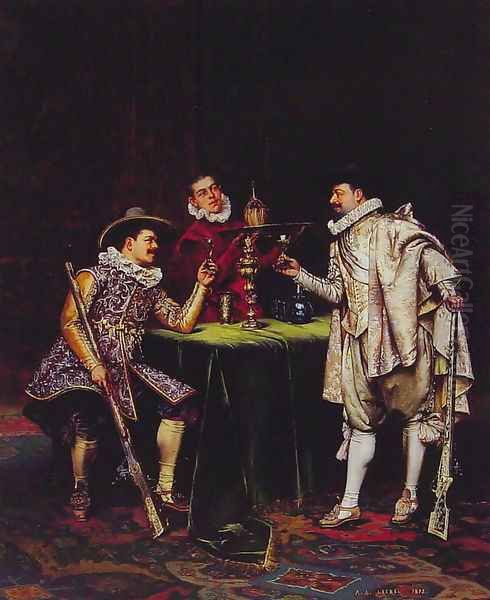
The detailed realism and romanticized vision of history presented in his paintings held broad appeal in the Anglo-American art market of the late 19th and early 20th centuries. His works were acquired by prominent collectors and dealers. The fact that his paintings continue to appear regularly in auction catalogues today attests to their enduring appeal and market presence. While perhaps not considered revolutionary by art historians focused on modernism, Lesrel's work has consistently commanded respect and high prices among collectors specializing in 19th-century European academic art. His name remains synonymous with high-quality historical genre painting in the tradition of Meissonier.
Later Life and Legacy
In 1907, Lesrel returned to his roots, moving back to his native region of Genets. His life, like that of many Europeans of his generation, was impacted by the outbreak of the First World War in 1914. Despite the turmoil of the war years, Lesrel survived the conflict. He continued to live in Genets, reaching an advanced age. Adolphe Alexandre Lesrel passed away in 1929, nearing his 90th birthday.
His legacy is preserved through his numerous paintings, which are held in private collections worldwide and in several public institutions. The source material confirms that his works are included in the collections of the Musée des Beaux-Arts in Nantes and the Musée des Beaux-Arts in Rouen, both significant regional museums in France. These institutional holdings ensure that his contribution to French art remains accessible to the public.
Lesrel represents a specific, highly skilled branch of 19th-century academic painting. He mastered the art of historical genre, creating meticulously detailed and evocative glimpses into a romanticized past. While deeply indebted to the style of Meissonier, he sustained this tradition with distinction for decades, producing a consistent body of work characterized by its technical brilliance and nostalgic charm. He remains a key figure for understanding the enduring appeal of academic realism and historical themes in the face of emerging modernist movements.
Conclusion
Adolphe Alexandre Lesrel was a dedicated and highly accomplished practitioner of historical genre painting. Emerging from the rigorous training of Gérôme's studio and profoundly shaped by the detailed realism of Meissonier, he devoted his career to recreating the world of 17th-century France with remarkable precision and elegance. His paintings, filled with sumptuously dressed cavaliers engaged in refined pursuits within opulent interiors, captured the imagination of collectors in France, Britain, and America. Recognized by the official art institutions of his time and achieving considerable market success, Lesrel maintained his commitment to academic principles throughout a long life that spanned periods of dramatic artistic and social change. His work stands as a testament to the enduring allure of meticulous craftsmanship and the romantic appeal of the historical past in art.